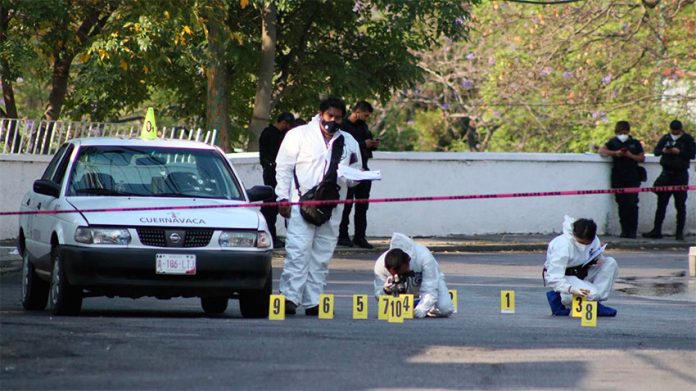May was the worst month for homicides since August 2020, according to daily figures published by the federal government that also show that murders have increased every month so far this year.
There were 2,462 victims of homicide and femicide last month for a daily average of 79.4 murders.
The preliminary figures typically undercount murders by 15% to 20%, meaning that final data, to be published June 20, will likely show there were close to 3,000 homicides and femicides in May.
The last time Mexico recorded a higher daily number of murders than in May was last August when the figure was 81.4.
Last month was the most violent May since President López Obrador took office in late 2018. The preliminary total of murders was 1.6% higher than May 2020 and 3.3% higher than May 2019.
The preliminary data also shows that average daily homicides and femicides have increased every month since December. There was an average of 70.8 murders per day last December, 76.7 in January, 78.7 in February, 78.8 in March, 79 in April and 79.4 in May. The average in May was 12.1% higher than the average in December.
The month-over-month increase in murders coincided with both the loosening of coronavirus restrictions as the intensity of Mexico’s pandemic declined and with the campaign period leading up to municipal, state and federal elections this Sunday. Scores of politicians and candidates are among the thousands of people who have been murdered in 2021.
Thirty months after López Obrador was sworn in as president and set about implementing a “hugs, not bullets” security policy that favors addressing the root causes of violence with social programs rather than combating it with force, homicide numbers remain alarmingly high.
The deployment of more than 100,000 troops of a new security force, the National Guard, and the ongoing use of the armed forces to carry out public security tasks have been unable to stem the bloodshed, with a new record for homicides set in 2019 before only a minimal reduction was achieved in 2020 even as authorities encouraged people to stay at home as much as possible to combat the spread of the coronavirus.
In May, Guanajuato retained its unenviable title of Mexico’s most violent state with 271 murders, according to the preliminary data. México state ranked second with 226 homicides and femicides followed by Michoacán, Jalisco and Chihuahua, with 222, 206 and 156, respectively.
Murders in those five states accounted for 44% of the total reported by the Public Security Ministry last month.
Guanajuato, where numerous criminal groups including the Jalisco New Generation Cartel and the Santa Rosa de Lima Cartel are fighting each other for control, has been Mexico’s most violent state since 2019. Celaya, a midsized city about 100 kilometers southeast of the state capital, was the most violent city in the world in 2020, according to a study by a Mexican nongovernmental organization. Irapuato, a city known as Mexico’s strawberry capital, ranked as the fifth most violent.
Authorities hoped that the arrest of Santa Rosa de Lima kingpin José Antonio “El Marro” Yépez Ortiz last August would help achieve a sustained reduction in violence in Guanajuato but after a brief decline in homicides rampant bloodshed returned.
Another state of concern is Zacatecas, which ranked as the sixth most violent state last month in terms of sheer homicide numbers. The northern state, whose location between Pacific coast ports and Mexico’s northeastern border with the United States makes it a drug trafficking nexus, recorded 130 murders last month, seven more than Baja California and 25 more than Mexico City, both of which have much higher populations.
A recent survey by Mexico’s statistics agency Inegi revealed that the crime-ridden city of Fresnillo, located 60 kilometers north of Zacatecas city, has the distinction of being the Mexican city where the highest percentage of residents say they feel unsafe.
Among the almost 2,500 murders reported in May were several that made headlines.
Three siblings – two brothers and their sister – were kidnapped and killed in Jalisco early last month, a crime that triggered a large protest in Guadalajara against violence and insecurity.
The assassination of Abel Murrieta, a former attorney general of Sonora who was running for mayor in Cajeme (Ciudad Obregón), on May 13 was another high-profile case as was the murder of Alma Barragán, a candidate for mayor in Moroleón, Guanajuato, who was shot dead on May 25.
All told, 13 candidates and politicians were murdered in May, according to Etellekt, a risk analysis firm. As is the norm in Mexico, the majority of the perpetrators of the crimes were not taken into custody.
One exception was a man identified only as Andrés N., a suspected serial killer of women who was arrested in México state on May 18 and admitted to killing and eating numerous women over a period of 20 years. But the 72-year-old would likely still be at large had his final victim not been the wife of a police commander, who took it upon himself to investigate the disappearance of his spouse.
Yet another high profile murder in May was that of Javier Barajas Piña, a 27-year-old human rights activist who was shot at least 15 times by gunmen in the municipality of Salvatierra, Guanajuato, on May 29. The man’s sister disappeared in 2020.
Final data for the first four months of the year showed that homicide numbers declined 4% compared to the same period of 2020 but with 11,277 victims between January and April, Mexico remained on track to record more than 30,000 murders for a fifth consecutive year.
The preliminary numbers for May indicate that the country not only continues to move toward that undesirable figure but is doing so at an even faster pace.
With a report from Animal Político (sp)
